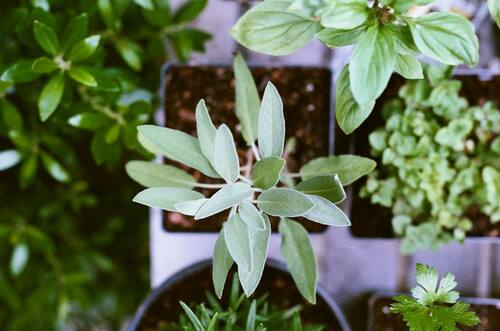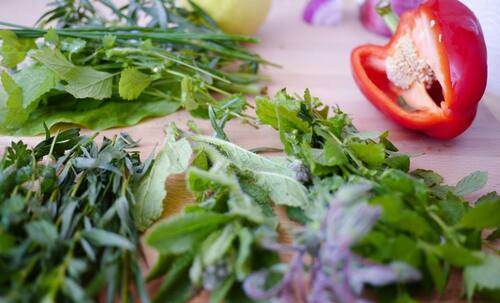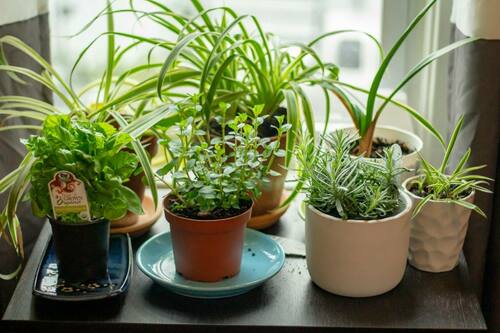Top Herbs to Grow at Home: Boost Your Garden and Health
Introduction
With so much food on the market being ultra-processed , it’s always healthier to eat fresh, clean foods that can help you avoid any dangerous chemicals. Many people grow backyard herbs to be more in control of what they eat for their own health and peace of mind. It’s also budget friendly ! Growing the best herbs for health can help home gardeners to get nutritional value out of what they eat. It also allows them to have fresh herbs for their meals. Fresh herbs still have the oils within them, making the taste strong. Hobby gardening is also a great way to get some outdoor time in nature.
Types of Herbs

Photo by Matt Montgomery on Unsplash
There are many easy herbs for beginners that don’t need much care but reward you with a delicious way to flavor your food. These are typically easy to grow and are a part of healthy home gardening.
Rosemary
One of the best herbs to grow at home is rosemary , and it’s a favorite for home gardeners because it grows large and needs little care. In fact, it grows so well that it can take over a garden if it isn’t trimmed back regularly. It’s grown as an annual in cold climates and as a perennial in others. Rosemary can be used to flavor various meats as well as casseroles and stews. It will also give you folate, vitamin C, vitamin A, and vitamin B6. It even has minerals in it including manganese, iron, calcium, and magnesium.
Rosemary needs to be grown in full sunlight in soil that allows for drainage. Rosemary plants should be planted about 2′ apart in an area that doesn’t have standing water after rain. Loosening up the soil and adding some potting mix into it can help it have better drainage. Most places get enough rain to sustain rosemary, but if a week goes by without rain, it may need watering. Adding some water-soluble plant food to it every spring can help it to grow better. Then, you can simply take off some leaves and throw them right into your dish. You can also freeze them to use later.
Basil
Adding basil to a dish isn’t just for the amazing taste—it’s also a way to get more vitamins into your diet. This herb has a wide range of nutrients in it, including vitamin K, vitamin A, iron, vitamin C, selenium, and more. There are many different variants of this plant that range in taste from sweet to spicy. The plant also comes in different sizes, so you can grow this herb even if your garden is tiny. Many people grow this in a container on a windowsill.
This delicious and aromatic herb needs plenty of sun and water. It’s a tropical herb, so it needs to be watered any time the soil is drying out. If the top inch of soil is dry, it needs watering. The soil should also drain well. You can add potting soil, sand, and/or small rocks to the soil to allow for good drainage. When you’re ready to flavor a soup, salad, pasta dish, or anything else that could use this flavorful herb, you can cut away the leaves you want to use. When the plant is 4″ to 6″ tall, pinch away the center set of leaves to get the plant to grow in fuller and bushier.
Parsley
This is an easy plant to grow that will go well in a lot of different recipes. It’s also a very healthy plant to eat. It has vitamin C, vitamin A, folate, calcium, potassium, and phosphorous as well as a good amount of dietary fiber for gut health. Parsley is often used in stews, pasta dishes, grain dishes such as quinoa, bean salads, roasted potatoes, and on various grilled vegetables. Parsley leaves can be cut from the stems and then chopped up and added to all of these dishes. It’s also a pest-repelling plant that can be a good addition to an herb garden.
To grow parsley, space plants about 6″ to 8″ apart in an area that gets full sun and has soil that drains well. If you live in a particularly hot climate, be sure that it gets shade during the hottest part of the day. It’s tolerant of poor soils, but it grows better if you can make the soil richer through the use of potting mix or compost. The plant needs to get plenty of water one or two times a week. Let the plant grow for a while before harvesting. Wait until there are five to ten main stems growing before you harvest the leaves. When you cut the stems off at their base, parsley will grow back. This also allows the plant to get bushier.

Photo by Thomas Rehehäuser on Unsplash
Thyme
Thyme is a particularly easy herb to grow. Among the culinary herbs for garden growing, this one has a unique aroma that is a pleasure to have in the garden. It’s also a healthy addition to your cooking. Thyme has plenty of vitamins and minerals such as vitamin C, vitamin A, selenium, iron, potassium, magnesium, calcium, and manganese. This herb is often used in marinades as well as on roasted vegetables. It can be used in soups, on roasted meats, and on fish. It’s even used in savory baking by mixing it with dough for a pop of flavor.
Thyme should be planted at least 12″ apart. It needs to be planted in an area that gets plenty of sun and that has well-draining soil. Adding some compost or potting soil that includes compost is helpful for enriching the soil around it. It needs to be watered regularly. Water it when the top inch of soil gets dry. Once the plant has become established, you can harvest it by cutting off the leaves as needed. Don’t remove more than a third of the plant at a time, however. It’s a perennial in many areas, and it stays green over the winter.
Sage
Sage is a great-smelling plant that can add a lot of flavor to a variety of dishes. It’s used on potatoes and carrots as well as in stews and sauces and along with various meats. It’s often used in addition to rosemary and thyme to create a rich flavor profile. Many home garners love to add sage to their chicken for a unique, piney flavor that elevates the dish. It’s also one of the best herbs for health. It’s ultra-low calorie, and it contains magnesium, potassium, phosphorus, beta-carotene, folate, vitamin K, and vitamin A.
This backyard herb is simple to grow and doesn’t need much care. The plants should be planted at least 18″ apart. It will tolerate either full sunlight or partial shade. The soil it’s planted in has to be extremely well-draining. Adding some pebbles or sand or potting mix to the soil is recommended, especially in areas that get a lot of rain. If the top inch of soil is dry, it needs to be watered. In the early spring, prune back the plant sharply, getting rid of the oldest foliage. This will spur the plant to make more of it. During the plant’s first year, harvest leaves sparingly. After that, you can harvest as much as you like by pinching off a leaf or cutting off an entire stem.
Oregano
Oregano is a popular herb and is an easy herb for beginners. It’s packed with nutrition , including folate, several B vitamins, vitamins E, K, C, and A, selenium, iron, calcium, phosphorus, potassium, magnesium, selenium, and lutein. With so much nutrition, adding it to a dish is a great way to make it healthier. Oregano is often used with fish, cooked vegetables, pork, chicken, omelets, eggs, sauces, and vinaigrettes. It’s especially popular in tomato dishes and tomato sauces.
Oregano should be planted at least 12″ apart. It likes full sun, but if you live in a very hot climate, it may need some afternoon shade. The plant is fairly tolerant and hardy, and it doesn’t need to be watered often. If the top 2″ of soil are completely dry, you can water it. The soil has to drain extremely well to keep the roots from rotting.
Herb Garden Design

Photo by Bonnie Kittle on Unsplash
Your backyard herbs need to be planned well so that each plant gets what it needs. All of these herbs to grow at home have a requirement for full sun, while some also need to have afternoon shade. Pay attention to how much sun different areas of your yard get and choose just the right place. If you live in a very hot climate, you may need to find an area that has afternoon shade but full sun during other times of the year.
Once you’ve found the best place to plant your herb garden, you can choose between in-ground and raised garden beds. Using a raised bed that’s filled with potting soil, some loose soil from the ground, and compost is ideal. However, you can get great results from in-ground planting as well if you loosen up the soil sufficiently. A tiller, hoe, or shovel is needed to break up the soil and make room for the ingredients you’re adding to it. Once the plants are established, you can also use a small amount of fertilizer to help them thrive.
One way that many at-home gardeners keep pests away from their beds naturally is by planting pest-repelling plants interspersed with the other plants. Parsley is a great plant to do this with because it’s also useful in foods and highly nutritious. You may want to otherwise group your plants according to their sizes. Then, make sure the garden has plenty of room in between the various types of plants. This is an attractive way to design a garden that also makes sure there is good airflow around the plants. Use mulch on top of the soil to keep weeds down and to preserve some of the moisture in the soil.
The shorter plants that can tolerate shade can be placed beneath the taller plants to give them the shade they need. The taller ones should be planted at the northern end of the garden and the smaller ones should be in the southern end. If you have only a small space to plant your herbs, concentrate on using smaller, compact plants in your garden.
You can also container garden. The plants can be placed in plant pots or in planters. Make sure you put the planters where the best sun is for each type of plant. You can also grow many herbs inside in containers that are placed in windows with southern exposure.
Grow Your Herb Garden

Photo by Pille Priske on Unsplash
There are so many benefits of growing herbs at home that it’s no wonder that herbs are such popular plants. They can be grown inside or outside, and they tend to be pretty tolerant of many conditions. When you raise herbs, you get foods that you know the origin of, and you can control the growing conditions. If you don’t want pesticides or herbicides on your herbs, you can simply not use them. You also get plants that are useful in many different dishes and that are nutrient dense.
If you’ve never grown any of your own food, an herb garden is a great first step. Many herbs don’t need a lot of care, and they provide you with an enormous amount of herbs given the small amount of them that you need for each dish. Many will grow back after you harvest some leaves, and some are perennials that will come back again the next year or for several years. It’s a step toward living a healthier life with healthier, fresher food on your plate.


